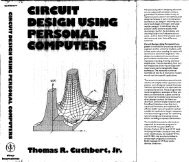Cuthbert, 2000 - IEEE Global History Network
Cuthbert, 2000 - IEEE Global History Network
Cuthbert, 2000 - IEEE Global History Network
Create successful ePaper yourself
Turn your PDF publications into a flip-book with our unique Google optimized e-Paper software.
⏐ρ⏐<br />
⏐ρ⏐<br />
φ<br />
1<br />
0.9<br />
0.8<br />
0.7<br />
0.6<br />
1.0<br />
0.9<br />
0.8<br />
0.3<br />
0.7<br />
0.6<br />
⏐ρ⏐<br />
0.5<br />
0.4<br />
0.3<br />
0.2<br />
0.1<br />
0<br />
0 30 60 90 120 150 180 210 240 270 300 330 360<br />
φ<br />
0.4<br />
0.5<br />
Figure 2. Origin of reflectance curves versus variable.<br />
+<br />
E S<br />
Z S<br />
N k<br />
N 1<br />
1 2<br />
jX<br />
Z L<br />
⎛ A B⎞<br />
⎛ 1 jX ⎞<br />
⎜ ⎟ ⎜ ⎟<br />
⎝ C D⎠<br />
⎝ 0 1 ⎠<br />
N 2<br />
Z 1<br />
1 2<br />
1 2<br />
jB<br />
⎛ 1 0⎞<br />
⎜ ⎟<br />
⎝ jB 1⎠<br />
1<br />
⎛ t<br />
⎜<br />
⎝ 0<br />
N 3<br />
2 t:1<br />
0 ⎞ ⎛ cosθ<br />
−1 ⎟ ⎜<br />
t ⎠ ⎝ jY0<br />
sinθ<br />
N 4<br />
1 2<br />
Z 0 θ<br />
Figure 3. Interfaces for lossless subnetworks.<br />
jZ0sin<br />
θ⎞<br />
⎟<br />
cos θ ⎠<br />
Typical reflectance cross sections versus a series inductance are<br />
shown in Figure 4. The curves at each frequency are similar to<br />
segments of the φ curve in Figure 2 except for the skewing in the<br />
abscissa. The envelope is defined to be the worst-case reflectance<br />
and is composed of piecewise arcs; the derivative of the envelope<br />
is discontinuous where the arc segments join. Broadband<br />
matching problem (3) is solved by finding the element values in<br />
vector x for the common minima on their respective envelopes<br />
and varying that x to obtain the lowest-possible minimum<br />
reflectance. Further consideration of Figure 4 shows that<br />
additional passband frequency samples would interpolate<br />
between reflectance curves at adjacent frequencies and only more<br />
precisely define the envelope, so choice of samples is not critical.<br />
It is important to observe the reflectance curves for ω = 0.4, 0.5,<br />
and 0.6 rad/s in Figure 4. They are still just segments of the φ<br />
curve in Figure 2, and it is not unusual for all sample frequencies<br />
to produce a monotonic (no minimum) envelope as opposed to a<br />
unimodal envelope for certain element variables. If only those<br />
three particular frequencies in Figure 4 are considered, the series<br />
branch would be unnecessary and would be removed (L=0)<br />
under the condition that no other elements were changed.<br />
Figure 4. Typical reflectances versus a series branch<br />
inductance. Each normalized frequency curve is a<br />
skewed segment of the curve in Figure 2.<br />
3. DIRECT SEARCH<br />
The precise search described in Section 4 removes all<br />
unnecessary elements but must be started from an approximate<br />
solution to (3). Also, there may be many local minima of (3),<br />
especially when unnecessary elements are present. Classical<br />
insertion loss theory and other broadband techniques indicate<br />
that each element in vector x will be in the range 1/25≤x j ≤25 for<br />
sampled data and equalizers normalized to one ohm and one<br />
rad/s. Normalized L, C, t, and Z 0 values are explored within that<br />
range; only one L or C is varied in traps, the other C or L being<br />
dependent on a fixed null frequency. Well-scaled mapping<br />
functions are used to relate transmission line lengths to the x j<br />
range, which is in turn mapped to log space; see Figure 4.<br />
A typical nonsmooth surface at one frequency for two of many<br />
variables is shown in Figure 5; all sections resemble Figure 4.<br />
An efficient direct search technique for locating the global<br />
23.7<br />
0.226<br />
C 2<br />
22.6<br />
C 3<br />
0.237<br />
1<br />
C 3<br />
C 2<br />
0.499<br />
ρ<br />
22.6<br />
0.5<br />
0.9<br />
0.8<br />
0.7<br />
0.75<br />
0.9<br />
0.6 0.85<br />
0<br />
0.85<br />
C 2<br />
0.5 0.75 0.95<br />
0.7<br />
0.85 0.65 0.9<br />
0.95<br />
0.9 0.8<br />
0.95<br />
0.5<br />
1<br />
1 0.5 0 0.5 1<br />
23.7<br />
0.226<br />
0.237<br />
Figure 5. A typical envelope surface for two variables.<br />
minimum is to evaluate the envelope surface at a pattern of<br />
points in variable log space. Figure 6 shows such a pattern,<br />
which can be considered an archeological grid over the terrain in<br />
Figure 5. During a search iteration, each grid point defines a set<br />
of element values, and the worst reflectance over all frequency<br />
samples determines the envelope surface value. Some point in<br />
the pattern will have the least worst-case reflectance, so the<br />
pattern is recentered on that point for another iteration.<br />
When a better point cannot be found, the pattern granularity<br />
(point spacing) is reduced by factor 4, and the search is restarted.<br />
A noncritical choice is to center the initial grid on unity; then<br />
only three reductions in granularity are required, a total factor of<br />
1/64. The number of pattern trial points is decreased as the<br />
1<br />
0.9<br />
C 3<br />
0.85<br />
V-402

















